“Stories Want to Create Patterns”: Ram V and Dan Watters on the Making and Mysteries of The One Hand and The Six Fingers
Crossovers aren’t new by any means. That’s been happening in comics for decades now, as two (or more) titles forming a single narrative is a tried and true method for comics of all varieties, even if they’re more notably connected to superhero stories. And yet, there are different ways you can handle that kind of thing, as the teams behind the upcoming The One Hand and The Six Fingers at Image Comics are setting out to prove.
The One Hand’s Ram V and Laurence Campbell and The Six Fingers’ Dan Watters and Sumit Kumar — with colorist Lee Loughridge, letterer Aditya Bidikar, and designer Tom Muller acting as the tie that binds between the two titles, with all three working on both — are telling two sides of the same story, and doing so in a way that creates a third truth for readers to unlock as they read. The former explores the story of detective Ari Nasser on his final case in the city of Neo Novena, as he endeavors to put away a third iteration of the “One Hand Killer” before he puts a bow on his decorated career, while the latter follows archaeology student Johannes Vale who is very surprised to find out he’s apparently the killer, with the act of violence he doesn’t remember committing uniting these two disparate individuals.
Both The One Hand and The Six Fingers are strong works in the way you’d typically expect from these creative teams, but that two stories that are one (or even a third) approach gives it a little something extra that can make these two titles feel wholly unique when read together. With the former on final order cutoff next week and arriving in shops in the first week of February, 1 it seemed like it’d be a good time to dive into the streets of Neo Novena with the two architects behind these titles in Ram V and Dan Watters, as we recently hopped on Zoom to discuss the long journey for these two comics, how they came together, the central cast, the exemplary creative teams they’re working with, how this approach pushes readers, some of the exciting things they’re doing to connect these comics, and more.
It’s a great chat with two of the strongest writers in the game right now — a spoiler-free one, too! — and it’s open to non-subscribers as well. You can read it in full below, with this interview having been edited for length and clarity. If you enjoy the chat, consider subscribing to SKTCHD for more like it. Also, join me later this week for another chat with Ram with another of his collaborators in Evan Cagle, as we discuss their upcoming Dark Horse series, Dawnrunner.
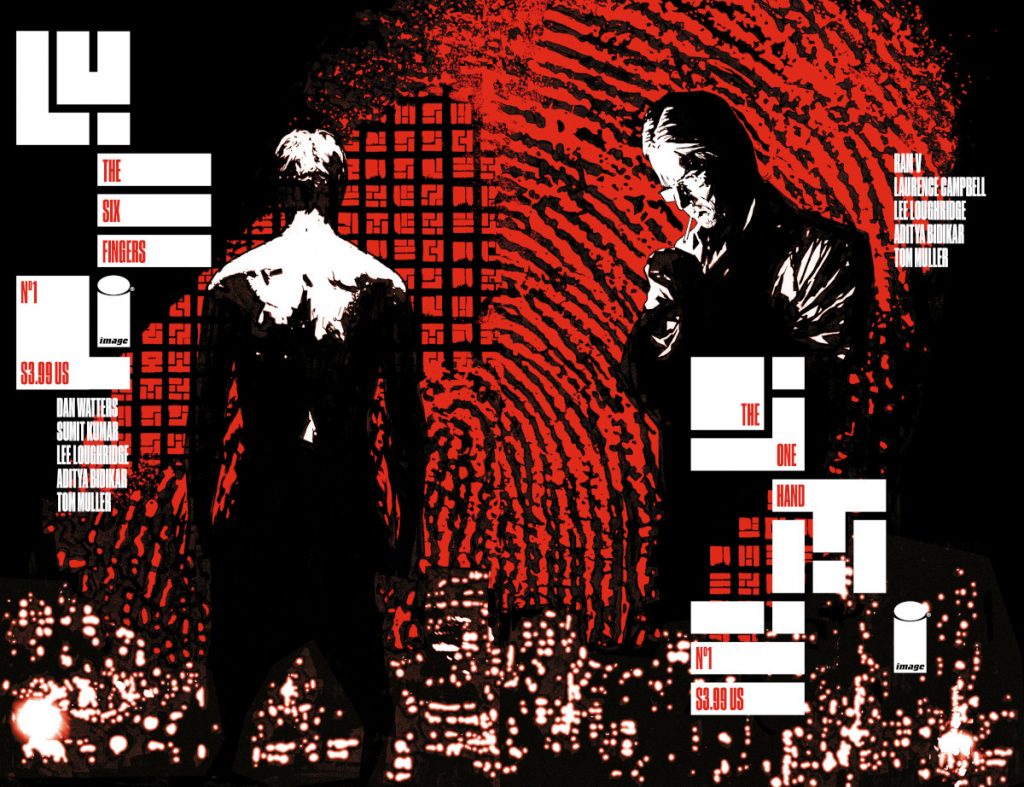
I want to start with when The One Hand and The Six Fingers started coming together, because I actually looked back in the history of my Friday column, and the first time I mentioned it was back in March of 2022, because, Ram, you actually wrote about these books in your newsletter back when they were dubbed, and I quote, “Project Gemini.”
Ram: I mean, I still have a folder on my Dropbox that’s called Project Gemini.
That was before you’d even announced your Detective Comics run, which was just revealed to be ending. It’s amazing how sequencing works. You even included an inked version of the first page The One Hand from Laurence Campbell then, so clearly this has been in the works for a while. When did this all start coming together?
Dan: It started with a DM from Ram at 4 AM. It was something along the lines of “You up?” but I don’t think it was meant that way. He’d had this idea. He’d been reading Cormac McCarthy, and we very quickly snowballed it at the time. Then it ended up back-burnered for quite a long time. This might have been…What year would that have been? 2019?
Ram: Yeah, probably 2019.
Dan: It’s been a back pocket thing for a good long while. We wanted to make sure it was well-fleshed-out before we started putting pen to paper, but also that we had the right collaborators, so that took a while to bounce around. We knew we needed artists who could work very in collusion with each other, so that the books wouldn’t look the same. We didn’t want two books that looked the same either. That was a delicate balance to work out.
Ram: It was a combination of reading Cormac McCarthy and then listening to a podcast that Dan recommended to me— called Philosophy Bites. The podcast was talking about Post-Work Societies, and how this idea that one day the machine singularity would happen and machines would make more machines, and they would do all our work and we would be free to pursue higher knowledge. Which is a funny thing to listen to right after reading McCarthy’s The Sunset Limited, where he says, “The pursuit of all knowledge leads only to darkness.”
My brain just went, “Oh, there’s a story there.” It did that at three in the morning. So, I messaged Dan, and I went, “Can we chat?”
You both are part of White Noise, a studio/comics collective with your fellow writers Alex Paknadel and Ryan O’Sullivan. Is this how you normally operate at White Noise? If you have an idea, would you normally start ping ponging it between the two of you? Or with this, Ram, did you specifically reach out to Dan thinking, “What if we did this together?”
Ram: Yes to both. This is how we operate, but also in this case very specifically, I reached out and went, “I think this needs to be two separate narratives that in coming together provide a third narrative”. Which is interesting also because now that I think back to Sunset Limited, it’s presented that way. Two people conversing with differing points of view, and then in listening to that conversation, you end up with the story.
And so, because in my head, that idea was born that way, I reached out to Dan and I said, “Hey, we should collaborate on this. We should write two stories that tell this third story”. But also in general, the number of times the three or four of us will be messaging each other going, “Hey, I’ve got to pitch this. I’ve got a seedling of what this needs to be. You think we can talk it out and I can figure out a story from it?” The number of times Alex, Ryan, Dan and I have done that for each other is pretty standard.
Dan: It’s the point of the studio is that we give each other a free pass to do that. But I also liked that you were listening to a philosophy podcast and then you were like, “We need to make this as dialectic as we possibly can. We’re going to make a Hegelian comic book.” (laughs)
Ram: Yes. That was definitely the intention. (laughs)
I always hear from creators, really writers in specific, that sometimes ideas come from marrying two ideas together. It’s just like, “Oh, I love this movie, and I love this TV show. Just what if they were together?” or something like that. I think that Ram might be pushing the boundaries of that idea by marrying Cormac McCarthy and a podcast together, which is not a combination I ever would’ve expected, but hey, it’s working.
Dan: It’s not even a normal Cormac McCarthy. It’s Cormac McCarthy’s play script as a novel, which you then match together with a podcast.
Ram: I very recently mentioned a (Haruki) Murakami quote on Twitter where he said, “If you’re reading what everyone else is reading, you’re thinking what everyone else is thinking,” which is a really cool quote. I bet nobody else is thinking of marrying a Cormac McCarthy play script and a podcast.
That is definitely an original take.
Okay, so you reached out. The idea that you had is you wanted to tell two narratives to become a third one. The actual plot, the story was something you two built from there. Is that the case?
Ram: I think the idea had its central philosophical quandary at that point, and I think we also had the idea of it being a detective story. Also, I remember that partly because at the time, Dan knows this, I was also very obsessed with Paul Auster and these late ’80s American detective stories being used as a vehicle to talk about interesting things, which is what he did with City of Glass. I think we had those pieces. It was a detective story and it had its central philosophical conceit, which we won’t reveal obviously. The idea is that you read both books and you get it from there, but it had those two things and then nothing else beyond that.
Dan: Yeah, it’s really built in a more organic way than I think a lot of the stuff that both of us work on in terms of… I think we had the end from the beginning. But everything that joins the beginning of the story to the end of the story in both projects — because they sort of end in different places because they’re different books — everything in-between that grew very organically and it’s been a very like…one has bounced off the other and then bounced off the other as it’s built issue by issue.
Ram: Yeah, and I think that’s part of the joy of collaborating. Doing it that way rather than, we both sat down and figured it out and then divvied up our pieces.
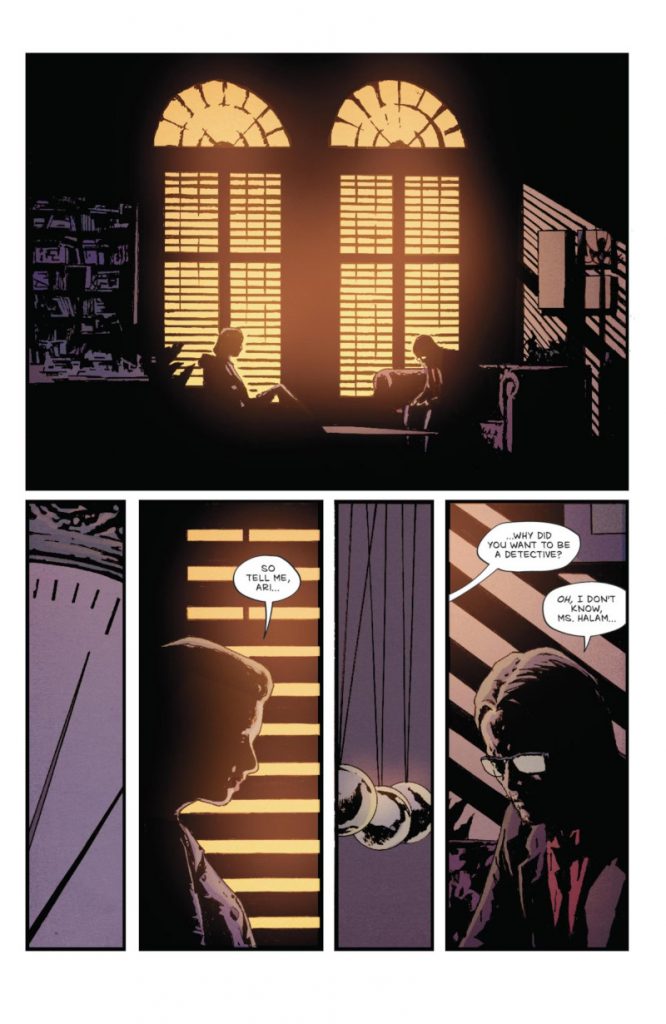
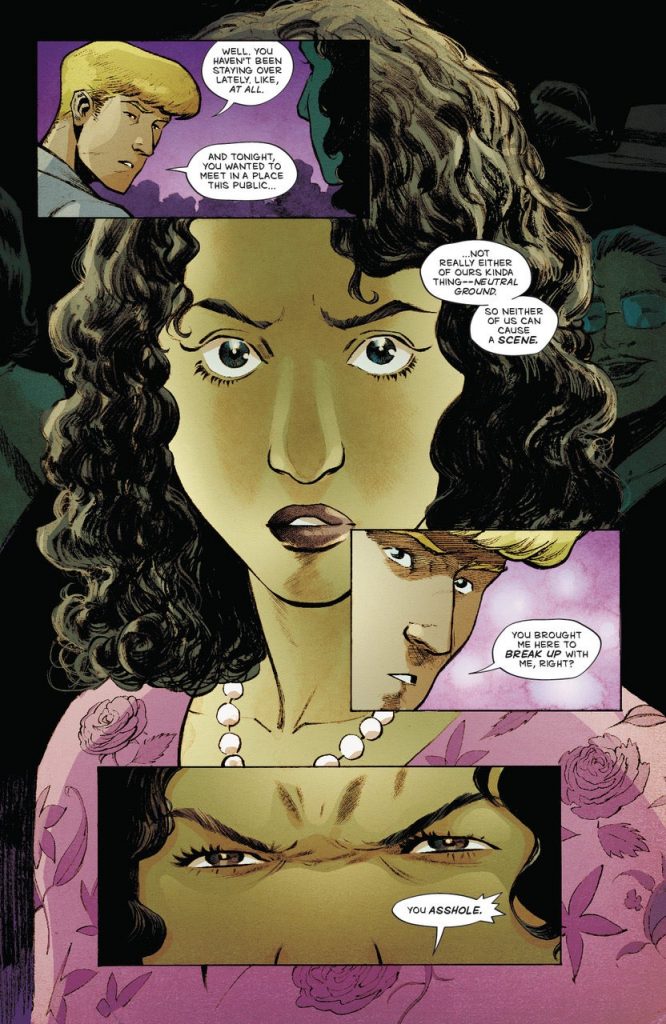
I think it’s funny. I was reading the press release where, Dan, you said, “We’re doing something with these books that I’ve never seen in comics before,” and Ram, you said, “It’s ambitious, seeking to do things in the medium and unlike anything I’ve made before.” Initially I was thinking, “Oh, it’s just the two narratives that form one.” But now it seems like it’s less about that and it’s more about how it forms that third narrative or that third truth and ends up being something different than you expect based on the individual narratives. What’s exciting you so much about this, besides the collaboration element?
Ram: Well, I think we’ve seen comics do crossovers, right?
Right.
Ram: Which is there’s one narrative going on and you’re seeing two pieces of it, but I don’t think we’ve seen comics do Rashomon or The Last Duel for a more recent comparison, which is present narratives from two different perspectives and therefore present two entirely different narratives and then allow a third one to emerge because it is only the reader or only the viewer who has insight to both narratives, if you will. Everyone except the reader and the creator is missing a piece of the puzzle.
Dan: It is just a long way of saying both our protagonists are stuffed. (laughs)
The two leads are Ari Nasser, who is a detective in Neo Novena and Johannes Vale who is an archaeology student. It is interesting because you’re tracking these two stories from these two different perspectives. But I would say at least to some degree with one and to a significant degree with the other, they’re not exactly reliable narrators, and right from the beginning you’re like, “I don’t really know how much of this is the real version of things.” It immediately puts you on your heels as a reader and it works really well.
But also initially, I was just like, “Oh, this is just setting up a mystery” and now I’m like, “Now I don’t even know what to expect. What the hell guys?” Was that an important part? Developing these two characters as… I don’t want to say the vehicle to get to this grand point, but you needed them to be not entirely trustworthy?
Dan: I think that’s a key component of any story, to be honest. You always want a strong enough protagonist that they’re trying to enforce their will on the world, and they need to be self-delusional enough to make things happen too. I think it was important on my end. I think it’s pretty clear it’s a book of the cop and the killer, or the guy who everyone thinks is the killer and maybe thinks he is and isn’t quite sure…I didn’t want to just do a bland serial killer guy who’s just out for evil and bloodlust and that stuff, because I don’t think that that’s a very interesting protagonist or a very interesting narrator in itself. Making sure he was more complex than that, both in terms of how he sees the world and how he moves through it…I think that was definitely a big part of it.
Ram: I think if you’ve done your job well, essentially both narratives or both protagonists are immersive enough or engaging enough for the world and the narrative to be moulded through their lens. We all are unreliable narrators in that sense, because we all want to be the protagonists of our own stories. Everything is warped and bent and changed to fit our own idea of who we are. I think that concept in itself speaks to the nature of the mystery and what we are trying to say about humanity and about people in general.
Dan: What we have with this one in particular is two characters who have very strong ideas of how the world works or how the world should work, and they think if they can just enforce that, then everything will be okay. That’s maybe why you get a particularly strong sense of them trying to interpret the world through these particular lenses.
Johannes definitely seems like he has a bit of control to him.
It seems like you developed every aspect of these books together. When it got down to the actual writing, did you two always know who was going to take the detective and who was going to take the killer, or was that fluid in development?
Dan: I think that came out pretty early, maybe in that first conversation.
Ram: Yeah. Like I said, I think in knowing that this was going to be a detective chasing a killer story when the idea was born, I certainly saw myself writing the detective at that point. But equally, and also I think interestingly…Dan, I know you mentioned this very early on when we started working together in terms of like, oh, this is not how you thought collaborations would work and that you were enjoying the fact that because I knew I wasn’t writing the killer, I had made sure to go to Dan and be like, “Look, I have no idea how this side of the story goes. You have to figure this out. In figuring this out, we are going to mould my narrative as well, because now I have to react to what you are doing in your story.”
I think that laid the foundation of how we’ve collaborated on these books.
Dan: I had the idea for the mutation. That was something I had knocking around before. It was an idea I wanted to do and use, but I hadn’t found a place for it yet, and that ended up being the title of the book and everything.
Ram: Yeah, the books owe their titles to Dan.
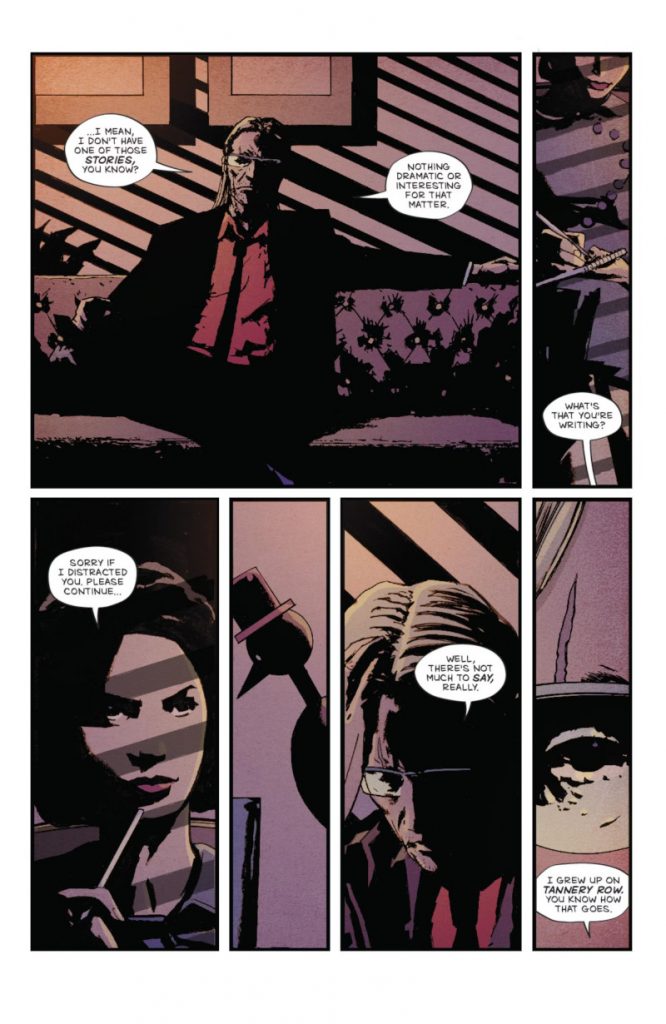
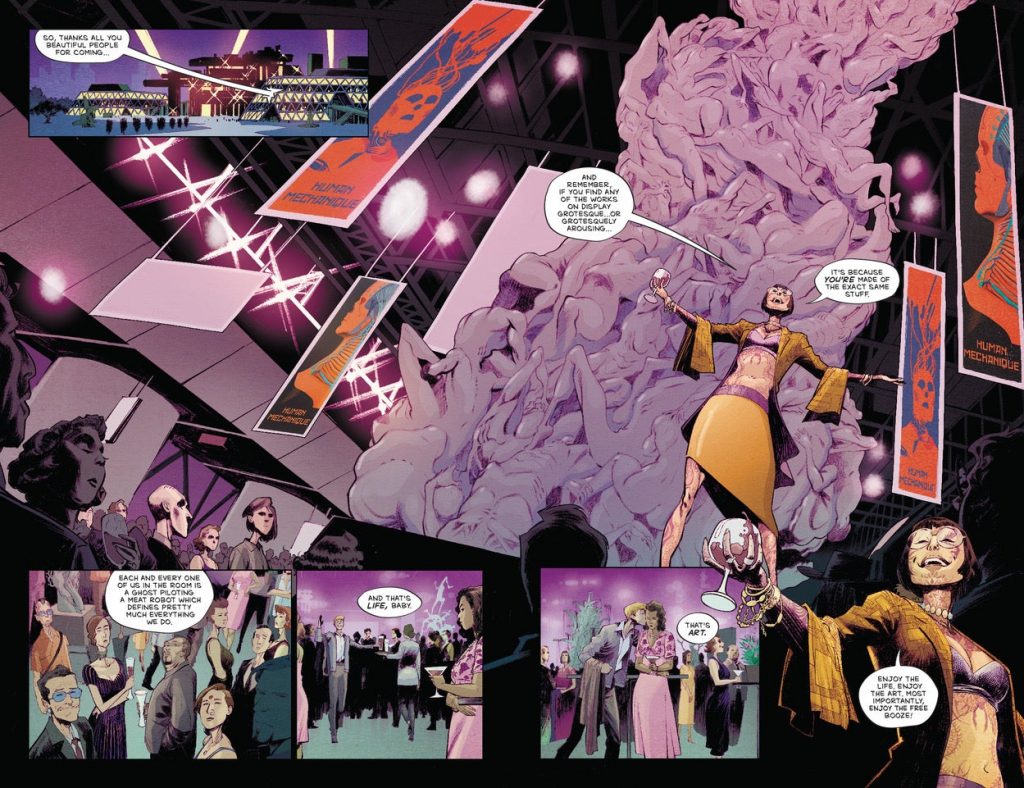
I want to go back to something Ram said specifically about you, Dan. He said that this isn’t how you expected collaboration to work. What surprised you about this? What made this feel different than what you expected?
Dan: To be honest, it goes back to what I was saying before in terms of it being something that was built very organically. Even when we were coming down to plot the last issues, there was still a level of fluidity to it. Ram’s a very…not firm outliner, but he definitely has an idea of where he’s going and I’ve become more like that the more I’ve written. That’s kind of been thrown to the wind a little bit on this one, but also there’s an alchemy to writing where things slot into place and it feels like, “Oh, I did this and now this is making that work and this is making that work.” That either happens or it doesn’t.
The projects where it doesn’t become the gruelling things where you have to make it feel like they did come together that way and that becomes the job. But when they do work, it’s phenomenal. It’s the best feeling as a writer. Being able to do that with two books with that many balls in the air I thought was going to be more of a challenge than it turned out to be.
Ram: It’s like that experiment where people put salt on a vibrating plate, and depending on the frequency, the salt wants to make a pattern. I feel like stories work very much like that. Stories want to make patterns depending on what frequency you’re vibing at. Dan and I vibe very well.
Stories want to create patterns, and I think that’s the inherent joy of writing these things is trusting yourself that by the time I get to the third act, I will know what the pattern is.
Well, especially because you had an idea as to where the book was ending. But I did want to clarify one thing. Dan, you two talked about this, and then you, at least from what I understand, developed The Six Fingers a little bit separately, and then you came back together and then you’ve plotted the issue by issue within that. Is that kind how you worked on this book, just to make sure it’s in sequence?
Dan: Yeah, pretty much. I think every issue or two in terms of us each writing one, writing issues our second issues or writing our third issues, we’d then sit down again. At some point, even if we were just in the pub together or whatever, we’d end up sitting down and going, “Okay, this is where we’re at now. Has anything changed? Has anything developed that we want to explore, which might go off in a slightly different direction so we could keep revising it?” Also, the fact the books have been in development for quite a long time allowed us to revise things and add and subtract as we’ve gone along.
Ram: Yeah, I think there’s a call and response element to it, even though we knew the bigger overarching picture. There’s definitely this sense of, cool, I’ve written my issue one. Now, Dan’s written his issue one. By the time I’m writing my issue two, I’m taking a call, I’m taking notes from what Dan has done in issue one so that I can develop issue two in a way that I can then go back to Dan and say “I did this, so maybe you can do this in your issue two.” There is a measure of that call & response, and I think that’s why it’s important to collaborate with someone that you know can play with you.
Did you actually work where Ram, you would write a script and then, Dan, you would read the script and then go onto yours? Or was it more separate than that?
Dan: No, it was pretty much like that. AS much as we could without obviously schedules get in the away and things. But sometimes I might start writing my issue when 15 pages of Ram’s were written, or 10 pages were written.
Ram: There were also outlines ahead of time. So, when Dan was writing his issue one, he knew what I was outlining for issue two and vice versa.
Well, and it’s interesting too because of how it ties into the visuals. There are a couple scenes you see in both, sometimes from a different perspective. It seems like to make sure that Laurence and Sumit have exactly they need, you’re going to need to be on the same page when it comes to those connective elements, I imagine.
Ram: Yeah, that was definitely the intent. I think very early on when we started, we knew there was going to be at least one scene in each issue that if you looked at both books, you realize it’s the same scene playing out from two different points of view. That happens in every issue. There’s one scene that plays out from two different point of views. I remember Dan and I sitting down and going like, “Okay, this particular scene, we definitely need to know exactly what we’re doing here, because we can’t go back to…” Because I can edit a line of script, but I can’t go back to Laurence to be like, “Can you redraw this panel?”
You could. It would just be really rude. (laughs)
Ram: I mean, to be honest, Laurence redraws his pages without me even asking. He’s like, “I did four options for this one page.” I’m like, “What? Why?” (laughs)
Dan: Sumit’s been doing that too. (laughs) I think they’ve been freaking Will out.
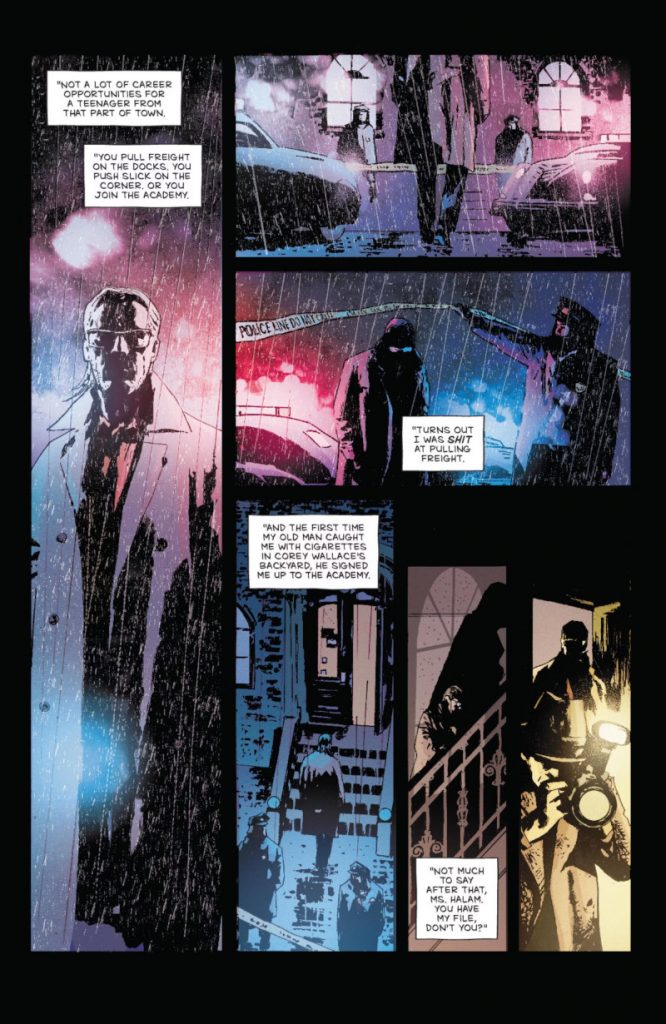
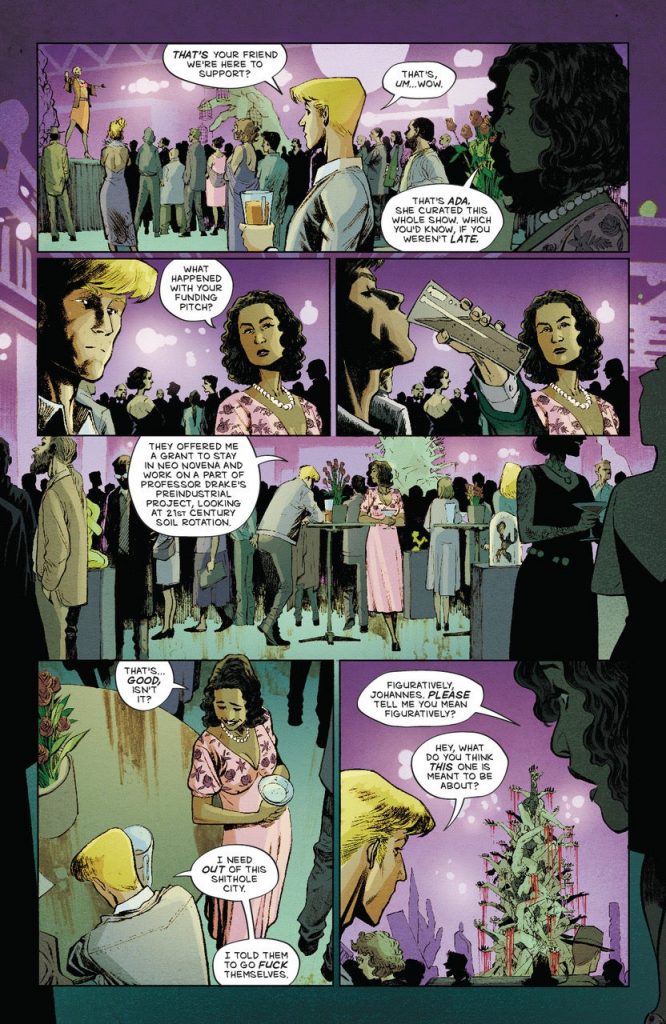
I’ve long thought Laurence was terribly underrated. He’s just an incredible artist and pretty much everything he does is amazing, and he’s perfect fit for this story. Sumit is someone you have experience with Ram, but he’s just an incredible storyteller that fits but also gives a separate feel to what Laurence is doing, so there’s a nice balance there. What made those two the right fit for this larger story?
Ram: I think very early on when we discussed this, much to my lack of vision, I was like, “Both books need to feel like they are heavy noir, dark, inky work.” But then credit to Dan’s feel for aesthetics, Dan came back and was like, “Actually, my book is a little bit more fluid. It’s a little bit more untethered.” We were looking at different kinds of artists. Dan was like, “I want somebody who can do that.” Then once we started looking at Sumit’s work, and I knew Sumit was going to be available at the time…I think he was finishing up some of his DC work as well. I think when we came down to that and then we started looking at the two styles, it made sense that one book was very rooted and tethered in reality, and the other one wanted to escape it almost.
I think that balance really plays out well, especially, and this is my favorite bit to tell people when I talk to them about these books. When you read both issues like issue one of mine and then you read issue one of Dan’s right after, there is always this moment of realization that at least as a creator, I can see in the reader’s eyes when they’re in front of me…I can see this sparkle come up. I think part of that is because of how the art from both books, they’re in conversation with each other. I knew I was going to work with Laurence very early on this, because I was like, “Okay, I know Laurence does this very specific noir take.” Then I think, Dan, if I’m not spoiling anything, the art gallery scene was when I knew, “Oh yeah, Sumit is perfect for this.”
Dan: I remember it took a lot longer to find an artist for The Six Fingers, partly because we didn’t think Sumit was going to be available, and then he was, so happy endings all around. But we were looking at quite a lot of different styles, because it needed to be something that could definitely carry that noir vibe. The books were in conversation, so they both really are at their core’s noir stories, but it needed a bit of a different flavor. I like that they look so in conversation with each other, but you can still look at any panel from each book and tell exactly which book you’re looking at. You’re not going to pick them up off the shelf and get confused by them.
It’s clear that it’s part of the same family, but you also know each has its own flair. I think that Sumit matches Johannes as a character really well. I also like that you have the same colorist on both. Having Lee Loughridge color both is a nice move, because it ties them together without both looking the same. It is interesting to see how many different ways you can bring Neo Novena to life, and he certainly finds the different ways, and that’s why you bring on somebody like Lee, I guess.
Ram: Yeah, and I think also not to forget (letterer) Aditya (Bidikar) and (designer) Tom Muller.
Of course.
Ram: They’re lettering and designing across both books. They definitely feel of a piece, even though they’re trying to also be distinct, which then you see is the philosophy of how we were wanting to tell the story as well.
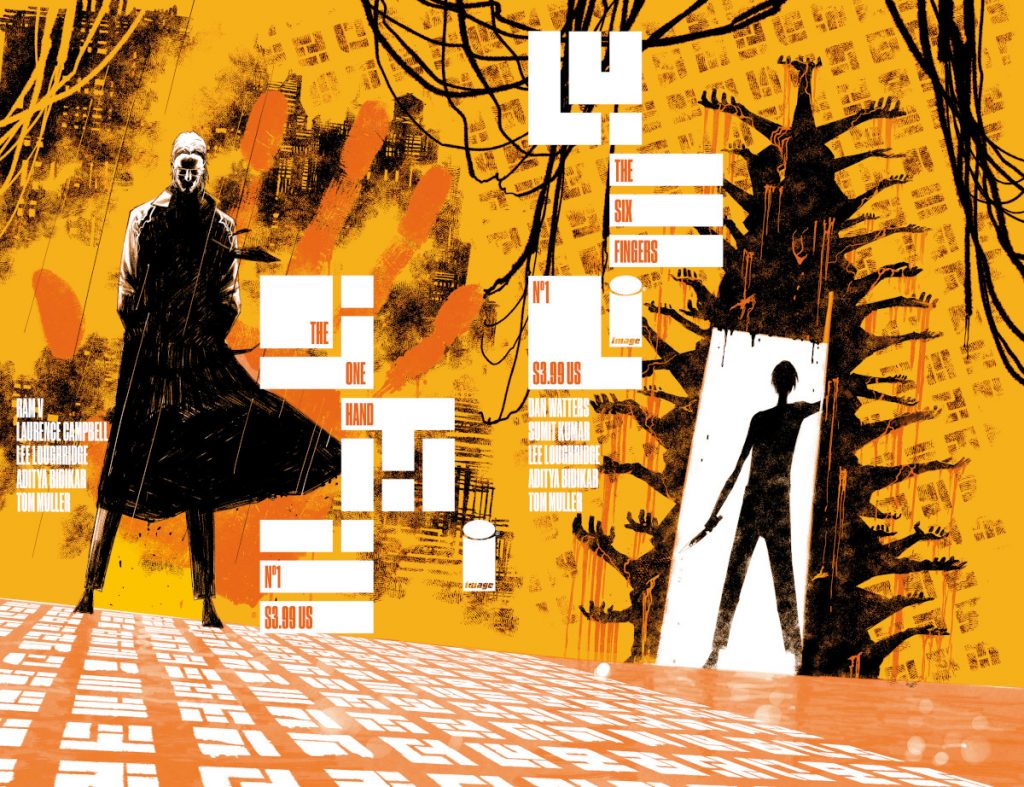
That’s one of the smartest things I think you did. Aditya doing the lettering, but also how the visuals connect so much on the covers in specific. I love that Sumit and Laurence both created covers for issue #1 for The One Hand and The Six Fingers that connect with each other, with one being red and the other yellow. It visually reinforces how they fit together for people who, let’s say, go into a comic shop, haven’t read a solicit, don’t know that these two books are necessarily connected. If you happen to get an industrious comic shop who decides to align them next to each other, suddenly, you’re like, “Oh, I guess I should be picking up both of them.”
But then the other thing is when you look at Tom’s design on the cover, you realize the uniformity and the connection between the two, and that seems like an essential reinforcement of the fact that these two books are…they’re not one, but they form one.
Dan: Yeah. The design was a big part of this book, particularly because there’s a sigil, which is like a code, that runs through the story, and that’s part of the central mystery. We had both worked with Tom before. He did Blue In Green for Ram, and he did Home Sick Pilots for me and Caspar. He was someone we’d both worked with before who we knew had a real flair for this thing and would jump into it with both feet. With the code being an important part of the story, Tom came in and designed that.
He designed the code?
Dan: Yeah. Then we looked for ways that we could work that into the design. It’s become a major part of the aesthetic of both books, and it felt like a very distinctive thing that we could use for cover design. Even when we’re looking at variants and having two artists always working on opening covers, you can immediately tell that it’s part of the project.
Ram: Pretty much everyone who’s worked on the covers — not just Laurence and Sumit, but the variant covers too, with Alvaro Martinez Bueno doing one, and Sean Phillips has done one — they’ve all done double page spread covers, so it’s always going to be spread across both books.
That is very smart.
I don’t know how much of this is how you’ve played it and how much is just the way it worked out, but the promotional material…it doesn’t really do a hard sell on the connection. The first half of the announcement was like, “Oh, this is The One Hand,” and it’s like this is an explainer of what it is, and in some ways…this is an oversimplification, but it’s mad libs of the same solicit that ends up being used for The Six Fingers. You read it and you connect the stuff yourself, but it’s never just like, “You have to read both.” Did you not want to go with that hard sell, or is this you wanting to build the connection but not force it?
Ram: Wait, Dan, you’re writing another book as well? (laughs)
Dan: I might’ve messed this up, man. You might’ve told me your idea…I was really drunk. (laughs)
Can you plagiarize each other? I don’t know how this works. (laughs)
Dan: Not at this point, not on this project. But yeah, I think it’s a thing of making clear that they’re complete books, they’re complete stories, and the crossover isn’t the only point. They are complete things in themselves as well.
Ram: Yeah, I mean, rather than say you can read them in isolation, I would say if you read one in isolation, you wouldn’t know that you had missed anything. Does that make sense?
Oh, absolutely.
Ram: But reading both books and seeing both journeys come to their culmination and hopefully having this realization of what’s actually happened is the point of this experiment, if you will.
You wanted to make it in a way where if you read an individual story, the person wasn’t going to be confused and feel burned by it, but if you read them together, it was going to enhance the overall experience.
Dan: Absolutely. Yeah. I would hate to do that with anything, to be honest. I would hate to create something that was incomplete by itself.
Ram: I don’t know that it’s an enhancement, though. The overall experience is the point, but the diminished experience isn’t incomplete, if that makes sense.
To your earlier point about not having the hard sell on…I think that speaks to what the books are trying to do. It’s a mystery. You’re supposed to put it together, including the fact that the format, you are supposed to literally put them together. Do you see what I mean?
Oh, yeah.
Ram: And so, the expectation of the reader begins before they’ve even read the first page.
I remember the day it was announced. Ram, on one of the 82 social networks that exist today, I think you were being like, “Hmm, interesting.” You weren’t saying, “Look, Dan and I are doing something together. Get on it.” You were a little coy about it. Because you’re right, I do think for a story like this, it feels better if you connect the dots yourself and it feels stronger when you do.
Ram: Yeah, plus comic book retailers are a canny bunch, and they will ensure if you’ve pre-ordered one book, they’ll be like, “Maybe you want to pre-order this other one as well.”
In a time like this where it’s a challenge to get attention for one book, I imagine having two books that are connected in a specific way like this…my god, am I making a case for Big Two crossovers right now? (Ram laughs) But having this rising tide that lifts both ships is beneficial because if you read The One Hand and then you come in two weeks later and you see a cover that looks very similar, and then you pick that up, they lift each other up.
Ram: Yeah, I agree. Also, don’t you feel like… Okay, I’m going to go into a story again. I watched a play by a theatre group called Punch Drunk. They do this immersive theatre thing where they take over a warehouse and they put on a play, and it’s not on a stage. It’s in the whole warehouse, and you’re supposed to walk through this whole place while they’re doing this play. The play is written in a nonlinear form, so you can choose to follow whatever character you choose to follow through the story. Some people will start off at the south end of the warehouse, and that’s where they’ll watch the story from, and some people will start off in the north end of the warehouse, and they will catch the story from there so no one has a complete piece of the story, until at the end of the show you all meet up in the bar and you start talking about the story, and you end up with a fuller and more interesting picture, if you will. Stories as a way of getting people to talk and put pieces together and glean information from each other.
I feel like for all the evils of social media, here we are today with platforms that enable people from disparate parts of the world with disparate interests to talk to each other. I feel like stories are a good way of getting people to talk to each other and ask questions and put pieces together. I feel like when this happens, there’s definitely going to be people who only pick up one book. Then when they go online and they realize, “Oh, wait, there’s a second book? Well, what’s that one about? Where did you get that one? Well, when does it come out?” It’s a conversation, and I think that is part of what I hope is the experience of reading these books.
Dan: I do remember very initially wondering if we tried to do it this way, was the publisher going to kill us (David laughs), but they were very supportive and had their own ideas.
Ram: Do you remember pre-COVID walking into the Image offices, sitting down with (Image Comics’ Publisher and Chief Creative Officer) Eric (Stephenson) and pitching him this idea?
Dan: Yeah.
Ram: We pitched the idea, he looked at us, he nodded, smiled, and went, “Cool, when are you guys doing it?” That was all. I thought, “Okay, good. He gets it.”
I have to admit, one of my questions was effectively, how did Eric Stephenson react to this?
Ram: We got a cool, which on the Eric scale is probably a 9 out of 10.

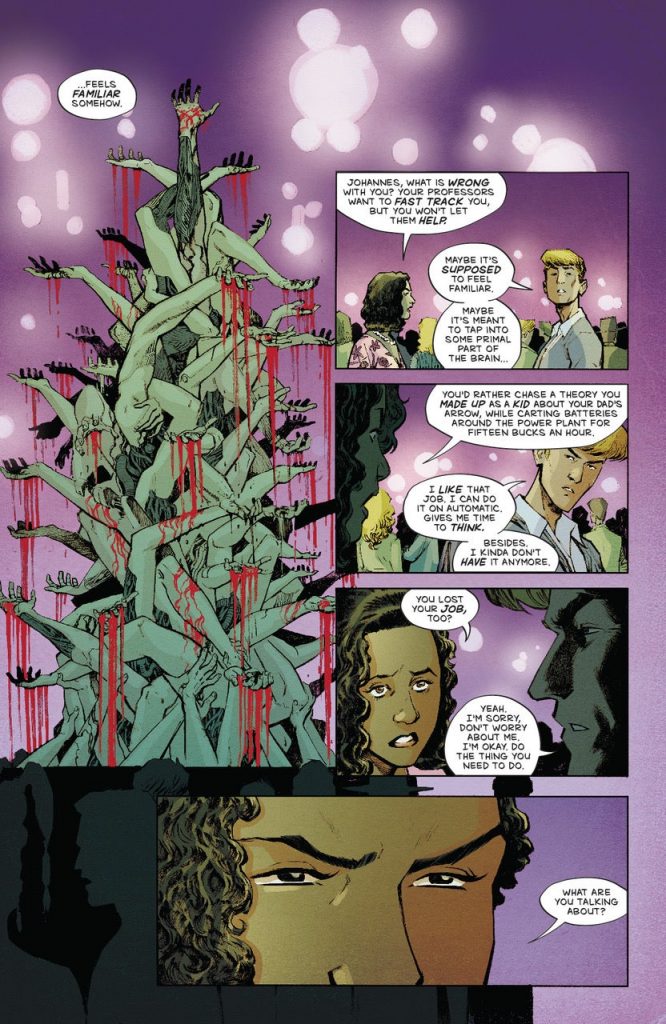
I could see something like a Neo Novena Book Club where one half reads one half, and then the other half reads the other half, and then they talk about it. It seems like the type of thing that encourages conversation and interpretation, which is really what you’re trying to do as a storyteller. You don’t want somebody to read something and immediately just be like, “Well, I guess that Ari guy’s weird.” You want them to actually engage with the story, and the way that you’ve structured it seems like it naturally asks a little bit more of the reader in that way.
Ram: Yeah. I know Dan feels similarly, but my philosophy has always been that every story is a pact. The writer is expecting the reader to engage with it in a certain way and put in some measure of effort. Otherwise, you’re just letting the story wash over you, which I don’t know…I never engaged with stories that way.
Dan: You might as well read the Wikipedia. But yeah, I think it’s always very much the goal to engage the reader and give them the pieces. But I think it’s also a thing of very much giving them the pieces to put it all together, because as he said, it’s a pact. The other pitfall on there is you can end up antagonistic to the reader where you’re not really giving them enough or you’re not really presenting them with enough pieces to create a whole or to not create a whole without doing a lot of work, which at a certain point becomes a chore. It worked for James Joyce up to an extent. But there’s a reason people talk about Ulysses rather than Finnegan’s Wake at your average book club.
Ram: Not the White Noise Book Club, no.
It seems to me that for this to work, you really need the characters and the world to be put together. When you were developing this to some degree over four years, I’m sure that it wasn’t just four years of constantly you guys DM each other, being like, “What about this? What about this? What about this?” But was building up Ari and building up Johannes and building up Neo Novena, was that world building and character building a big focus for you over that time?
Ram: know it seems like there’s a lot more of it involved, but frankly, I think both of us just immediately knew what the world was going to be. Obviously, we talked about it, but like I said, because it is call and response, no one’s saying, “I’m going to play these notes in this order, and then you’re going to play those notes in that order.” I’ve had conversations with Dan where Dan did this one very specific thing with how the world functions and how Johannes is able to experience it, and that part wasn’t part of my understanding of Neo Novena. But he mentioned it to me in issue two, and now here we are in issue four or five where the fact that the world functions like that is an instrumental part of the story that I’m telling.
Again, it’s that kind of collaboration as a consequence of the necessity of storytelling rather than as an exercise in itself, we’re not creating a soup and then picking ingredients from it. We each have a dish in mind, and our dishes are in conversation, so we’re talking about palettes rather than ingredients.
Dan: Most of the world building came out of story beats and story necessities. The power plant where Johannes works came out of necessities and my story, the existence of the cogs came out of a specific character the Ram wanted to use, and it all built like that.
I love the fact that this objectively very smart person was just like, “I’m just going to go into this dangerous area and I’m going to fix this thing myself, just because that’s how controlling I am about everything.” You’re a very smart person, but you’re also not very smart, Johannes. What are you doing here?
Dan: Those are always the best characters,
Very self-destructive in a very specific way. But hey, six fingers! Very small six fingers, but still.
Dan: Yeah, he got a sixth finger out of it.
I have to say, I am disappointed by the fact it’s 2873 and we’re still driving regular cars. Come on. What are we doing here? Can we have cool cars? What’s going on here?
Dan: I mean, it’s 2024 and we still don’t have jet packs, so…
That’s true. The world would be better if we had jet packs and fancy cars in Neo Novena in 2873.
Ram: We’re treading dangerously is close to spoiler territory. We can’t say any more on this.
This is part of the reason why I didn’t want to bring some of details up. There’s an idea I had from the first issues of both that I don’t know is true, but I felt like could be true, and based on you saying that line…I’m not going to get into it.
Ram: Yeah. I mean…read and you’ll discover.
Ram, I don’t imagine you’re getting up and DMing a lot of people at four in the morning with story ideas. Dan, I don’t imagine you read a lot of DMs at four in the morning that you get really excited about. It seems like for both of you, when you come across something new, it’s exciting, and when you have the chance to do something different, it’s exciting. How important is it for you to keep experimenting and pushing your work in interesting and new ways like you are with these two books?
Dan: I think anything else would be death, creatively and soul-wise. Genuinely, I think the other way it goes is that you just start telling the same story over and over again with a different skin on it. Sometimes, particularly when you have a lot of work, you have a lot of deadlines and you’re blessed to be in that position, then you can feel that start to happen a little bit. You can feel like, okay, you can fall back on familiar beats and familiar things. That’s always the moment, I think, where that would make me panic more than not knowing where to go.
Because that means that you are feeling creatively bankrupt. I have no interest in just making things that don’t interest me and don’t feel like something new and something interesting. It’s always about exploring an idea, exploring a character, and hopefully both at the same time. Those should always be new and fresh things to you, if not to everyone reading it.
Ram: Walking on a tightrope is way more exciting than walking on a sidewalk, and there are consequences to falling off in both places, but it’s much easier to do it when you’re writing books than actually walking in tightrope. I think the true joy of telling stories is when there’s some risk involved of failure and falling flat. The best comedians do it all the time. There’s always a risk of your joke falling flat, whereas showing a guy slipping on a banana peel on a black and white film has been classic for years, so why not just do that?
The point of why you create…and this has been an obsession of mine, talking to people on Twitter, writing Rare Flavours…the point of why you create is because you don’t know yourself what you are creating at the end, and hopefully you create something that means something to you. And the beauty of making art is that you put it out there into the world and you realize that, “Oh, wait, this thing that I made because it was interesting to me is also interesting to everyone else.” That comes from a place of actual humility rather than vanity— “Oh, I’m an artist. I made whatever I wanted.” And it leads and ties back into this idea of constantly wanting to push yourself. I don’t think either Dan or I think of it as pushing yourself. We just think of it as “Cool, what’s interesting to me to do next now that I’ve done this?”
Dan: “What’s next?” Yeah.
Ram: And so, as long as you’re pushing yourself to constantly keep yourself interested and entertained, you may fall flat once or twice, but you’ll always be doing interesting work.
The other part of it too is if you’re just doing the same thing as everyone else and you’re not embracing that side of yourself and embracing the stories that really push you…it goes back to that Murakami quote from earlier.
Ram: Yeah, if you’re reading what everyone else is reading, you’re thinking what everyone else is thinking.
It’s the same thing for what you’re putting into the world.
Ram: For creating.
Yeah, you’re putting the same thing into everyone else. Why are you giving anyone any reason to be interested in your perspective or your story? You’re just offering the same flavor as everyone else.
I will say, I have not had this flavor of comic before, so good job by you guys. The One Hand and The Six Fingers is a new one for me, which I really appreciate as a reader, because I want to finish a comic and feel like I hadn’t experienced that before. So…good job.
Ram: My genuine moment of joy with this was going to Will Dennis, who’s editing both books…I was talking to Will and I had pitched this idea. I don’t remember if you were there, Dan.
Dan: I think I was.
Ram: I just mentioned the idea to him, and Will went, “I’ve been editing comics for over 20 years, and no one’s pitched me an idea like this. So, you’re either crazy or very smart. We’ll find out. I’m in.”
Dan: The thing of, “If you read what everyone else is reading, you create what everyone else is creating,” I also think to put all the effort into honing this craft and doing this job and building it as a career, the reason you do that is because you love art and you love books and you love engaging with things, so it means you keep doing it, you keep engaging. Just even for leisure. You’re always engaging with new things, always trying to find things that you haven’t seen before that interest you. That also means that you’re always going to take those, and then you have new tools and you discover new ways of doing things. You see people do things in different ways, and you fold that all into yourself. Even when it’s not about like, “Oh, I need to do something new,” you just find yourself in a different place next time.
Thanks for reading this interview with Ram V and Dan Watters. If you enjoyed it, consider subscribing to SKTCHD to read more work like it, and to support the work I do.
As well as the latter shortly thereafter.↩
